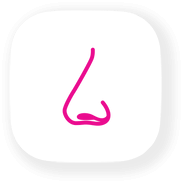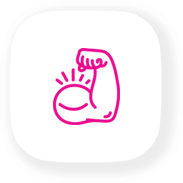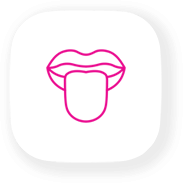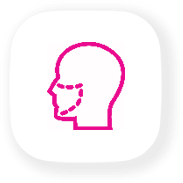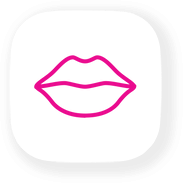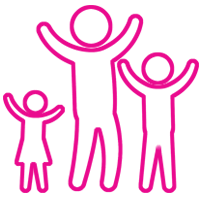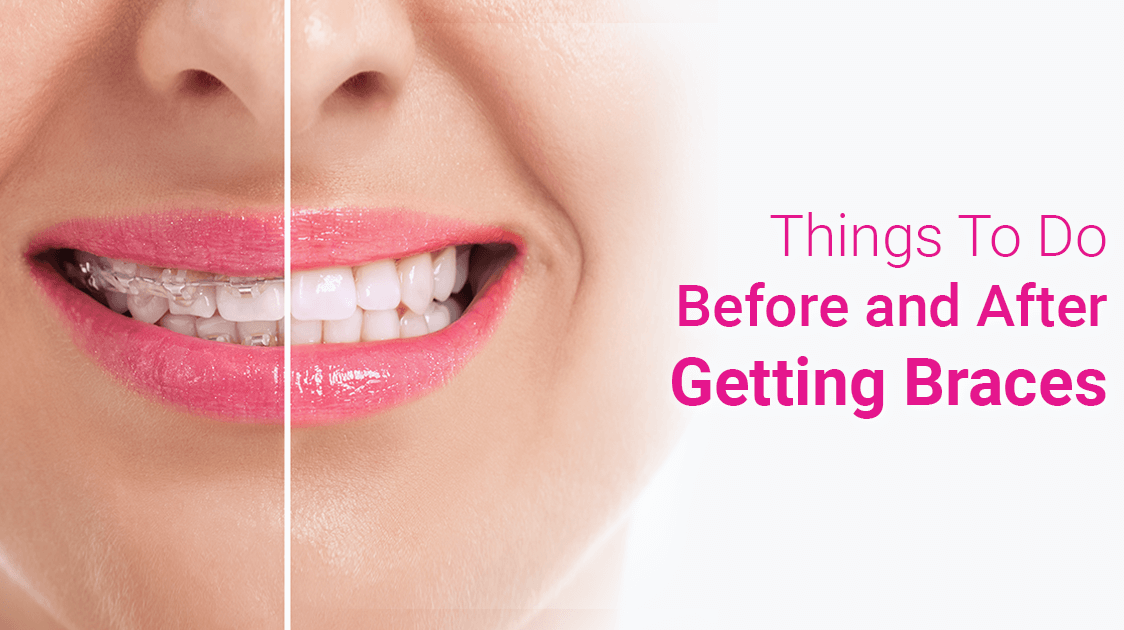Oral Myofunctional Therapy “OMT/ MFT/ Myofunctional Therapy/ Myotherapy”
WHAT IS MYOFUNCTIONAL THERAPY?
Oral Myofunctional therapy is an exercise program used to correct the improper function of the tongue and facial muscles. It involves strengthening of the tongue and orofacial muscles by teaching individuals how to tone and use the muscles in order to achieve essential functions like nasal breathing and swallowing.
HIGHLY EFFECTIVE PHYSICAL THERAPY EXERCISES TO IMPROVE
BREATHING, ORAL HABITS, SWALLOWING AND POSTURE
The habits we develop in our youth inevitably translate to behaviors later in life. By training the muscles in the face to act in their optimal biological way, muscle memory can keep the teeth and jaw in alignment as we grow and develop. (In many cases eliminating the need for future orthodontics).
WHAT ARE ORAL MYOFUNCTIONAL DISORDERS (OMD’s)?
Jaw growth
Face development
Teeth alignment
Oral hygiene and dental cavities
Chewing
Speech
Swallowing
Occlusion (the way teeth bite)
Oral habits like thumb sucking, nail biting
Pencil chewing, hair picking or curling etc
Teeth grinding or clenching
Stability of orthodontics treatment
Nasal breathing
Facial esthetics
Back pain
GOALS OF MYOFUNCTIONAL THERAPY
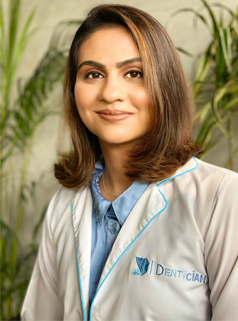
Dr. Ankita Shah and our Team at Dentician are grateful to be in position to provide online Oral Myofunctional therapy consultations for those suffering from airway issues, Orofacial Pain, Sleep Apnea, Tongue-tie and Speech Impediments GLOBALLY, in the comfort of their own home. We are honored to be considered emerging leaders in airway and breathing health in India.
MYOFUNCTIONAL THERAPY FOR OPTIMAL TONGUE TIE RELEASE
Myofunctional therapy is used as an important adjunct before and after Functional Frenuloplasty (tongue tie surgery) to achieve complete success out of the procedure. Before the surgery, Myofunctional Therapy tones the muscles, re-educates the tongue for performing the functions and prepares the tongue to undergo the release procedure. Our goal is to cultivate an awareness of muscle use and develop a therapy program of regular exercises designed specifically to meet your needs.
Just as physical therapy helps to train our bodies back into optimal shape after an injury, Myofunctional therapy helps by training the soft tissues of the tongue, face, neck, and mouth to function at the height of their ability.
Myofunctional Therapy involves the use of a therapeutic approach to tone these muscles in order to achieve essential functions like nasal breathing, swallowing which should come to us naturally. It also helps correct poor oral habits that restrict proper growth and development.
Thumb Sucking
Choking/ Gagging
Mouth breathing
Picky eating
Finger sucking
Lip biting
Snoring
Pencil Chewing
Drooling
Drooling
Tongue thrusting
Noisy Breathing
Pacifier habit
Nail Biting
Poor Posture
Teeth Grinding
Bottle feeding habit
Proper diagnosis allows for targeted and effective OMT exercises for oral posture retraining to promote better health with goals to improve breathing, swallowing, reduce pain, and enhance quality of life. Please refer to Academy of Orofacial Myofunctional Therapy for a more detailed explanation.
BENEFITS OF MYOFUNCTIONAL THERAPY WITH BREATH RETRAINING
The purpose of myofunctional therapy is to emphasize on correct resting posture of tongue and lips with the goal of facilitating proper nasal/ diaphragmatic breathing. The nose’s primary function is inhaling oxygen, followed by filtering air, warming and humidifying it which allows our body to get more usable oxygen. This in turn has a profound effect on growth and development of the face and airway. The benefits of Myofunctional Therapy when combined with Breath Retraining are:
Balanced moods
Clearer thinking
Healthy energy
Straighten teeth
Better facial symmetry
No Snoring and obstructive sleep apnea
Ability to move oral muscles properly
Increasing the tone and mobility of oral structures which can be damaged in apneic patients
Correct use of oral structures i.e. the tongue, lip and cheek muscles will help breathing, swallowing, suction and chewing
The Art of Myofunctional Therapy
We highly recommend that myofunctional therapy exercises be performed under the supervision of a certified and experienced pediatric dentist trained for myofunctional therapy and sleep dentistry. Please note that different sets of exercises are often recommended to each patient depending on the specific anatomic profile and orofacial dysfunction of each individual. The exercises prescribed are often modified and individually-tailored as appropriate according to a step-by-step treatment plan under the guidance of an experienced therapist.
MYOFUNCTIONAL THERAPY AS A CURE
Recent research has shown that myofunctional therapy may reduce the symptoms of sleep disordered breathing (such as snoring), and ameliorate mild to moderate OSA (obstructive sleep apnea). It has also been shown to prevent relapse of sleep apnea after surgical treatment. In addition, myofunctional therapy exercises play a critically important role in recovery after lingual frenuloplasty and to maintain the results of orthodontic treatment.
Our Globally Available Virtual Myofunctional Therapy:
FAQs:
Myofunctional therapy is used for treating orofacial myofunctional disorders (OMDs) in children and adults such as nasal breathing, TMJ disorders, teeth grinding or clenching, sleep disorders, mouth breathing, snoring, tongue thrusting, facial aesthetic, occlusion, neck & shoulder pain, headaches, back pain, poor posture, among others. This therapy helps strengthen the orofacial & tongue muscles and uses a combination of physical exercises to improve nasal breathing, correct oral & forward neck posture, and stabilise the jaw & joint of those with OMDs.
For tongue tie, Oral Myofunctional Therapy is used as an adjunct to rehabilitate the tongue function before, during, and after Functional Frenuloplasty. This therapy also helps avoid relapses.
Alterations in breathing, sucking, chewing, swallowing and speech, jaw pain, clenching and grinding of teeth, plus the incorrect position of the cheek, lips and tongue are some of the main problems related to OMDs.
It varies from person to person. Depending on the individual and the severity of the issue, Orofacial myofunctional therapy can be used before, during or post the orthodontics treatment. Get in touch with us for more information.
For patients with TMD, the focus of orofacial myofunctional therapy is to treat the root cause. OMT can help reduce pain and increase the range of motion and mandibular mobility, thereby greatly reducing the severity and frequency of the TMD symptoms. Post a thorough assessment, the OMT specialist will recommend techniques to restore the muscles of the face, mouth, neck and correct the functions of breathing, chewing, and swallowing.
To get the best results from your treatment, performing oral myofunctional therapy exercises under the guidance of an experienced, certified therapist is highly recommended. They will suggest tailored exercises based on an individual’s anatomic profile and orofacial dysfunction.
A myofunctional therapist can help individuals retrain their orofacial muscles and improve their functions. Some of the goals of myofunctional therapy are strengthening orofacial muscles, improving tongue position & oral rest posture, correcting swallowing, establishing continuous nasal breathing, among others.
It is a highly effective physical therapy exercise that helps improve posture, oral habits, breathing and swallowing. Like any physical therapy, Myofunctional therapy helps train the soft tissues of the face, neck, mouth and face, which, in turn, helps enhance their functions.
Usually, the fees for Myofunctional therapy ranges between 700-1000$. As a therapeutic service, this therapy is accessible virtually and globally.
As a physical therapy exercise, oral Myofunctional therapy is tailored to treat specific conditions based on an individual’s anatomic profile and orofacial dysfunction. The various sets of exercises are performed under the supervision of a certified and experienced pediatric dentist trained for myofunctional therapy and sleep dentistry. This therapy is accessible virtually and globally.
Blogs











